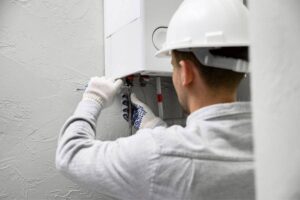Table of Contents
A well house is a small structure or shelter built over a water well. It provides protection for the pump, pipes, and other mechanical components that are part of the well system.

The primary role of a well house is to protect the well’s mechanical components from weather elements like wind, rain, and snow.
By doing so, it ensures the well’s longevity and keeps the water supply clean and safe.
Importance of Heating a Well House
Heating a well house is crucial, especially in areas that experience freezing temperatures.
Preventing Freezing During Winter
Without proper heating, water inside the well house can freeze, causing pipes to burst and damage to the well pump and other components.
This can lead to expensive repairs and a temporary loss of water supply.
Maintaining Optimal Operating Conditions
Heating maintains optimal operating conditions for the well’s mechanical components. It prevents condensation build-up, which can lead to corrosion and equipment failure.
Different Heating Solutions for a Well House
There are several different heating solutions available for well houses, each with its own pros and cons.
Depending on your specific needs, budget, and the climate in your area, some options might be more suitable than others.
Traditional Electric Heaters
Traditional electric heaters are one of the most commonly used heating solutions for well houses. These heaters are easy to install and operate.
They work by converting electrical energy into heat, which is then distributed throughout the well house. However, they can be costly to run, especially if you live in an area with high electricity prices.
They also require a reliable electricity supply, which can be a challenge in some rural or remote areas.
Propane Heaters
Propane heaters are another popular choice for heating well houses. They work by burning propane gas to produce heat.
These heaters are known for their efficiency and can quickly heat up a small space like a well house. However, they require regular refills of propane gas, which can add to the operating cost.
Additionally, because they involve combustion, proper ventilation is crucial to prevent the build-up of harmful gases.
Solar-Powered Heaters
Solar-powered heaters are an environmentally friendly option for heating well houses. They work by harnessing the power of the sun to generate heat.
This type of heater can be a cost-effective solution in the long run, as it can significantly reduce your energy bills.
However, the initial cost of installing solar panels and a solar heating system can be quite high. Also, the effectiveness of this heating solution depends on the amount of sunlight your area receives.
Heat Pumps
Heat pumps are a modern and energy-efficient heating solution. They work by transferring heat from the outside air to the inside of the well house.
Heat pumps can be a highly effective way to maintain a consistent temperature in your well house, even in colder climates.
However, they can be more expensive to install than traditional heaters. They also require a certain amount of outdoor space for the installation of the external unit.
Geothermal Heating Systems
Geothermal heating systems are another energy-efficient option that is becoming increasingly popular. These systems use the stable temperatures found deep underground to heat your well house.
While they can be one of the most efficient heating options available, geothermal systems can also be the most expensive to install due to the need for ground excavation. They are also not suitable for all locations.
By considering the unique advantages and disadvantages of each of these heating solutions, you can choose the one that best fits your needs and circumstances.

Installation Process of a Well House Heater
Here is a step-by-step guide to installing a heater in your well house.
Step 1: Assessing Your Well House’s Heating Needs
The first step is to determine the size and type of heater you need. This depends on factors like the size of your well house, its insulation, and the local climate.
Step 2: Choosing the Right Type of Heater
Select a heater that meets your needs and budget. Consider factors like energy efficiency, cost to run, and ease of maintenance.
Step 3: Gathering Necessary Tools and Equipment
You will need tools like a drill, screwdriver, wire strippers, and electrical tape for the installation. Always read the manufacturer’s instructions before starting.
Step 4: Preparing the Installation Area
Ensure the area where you will install the heater is clean and free from debris. If necessary, do some basic repairs like sealing gaps to prevent heat loss.
Step 5: Setting Up the Heater Unit
Follow the manufacturer’s instructions to set up the heater unit. Make sure it is securely mounted and positioned for optimal heat distribution.
Step 6: Connecting to a Power Source
Connect the heater to a reliable power source. If you are not comfortable doing this, hire a professional electrician.
Step 7: Installing Necessary Ventilation Systems
If you are using a combustion heater like a propane heater, ensure proper ventilation to prevent carbon monoxide build-up.
Step 8: Testing the Heater for Proper Function
Turn on the heater and check if it is working correctly. Monitor the temperature in the well house to ensure it is maintaining the desired temperature.
Step 9: Insulating the Well House for Optimal Efficiency
Proper insulation reduces heat loss and makes your heating system more efficient. Use materials like foam board or fiberglass batts for insulation.
Step 10: Regular Maintenance and Safety Checks
Regularly check your heater for any signs of wear or damage. Clean it as per the manufacturer’s instructions and replace any worn-out parts.
Safety Measures When Heating a Well House
Safety should always be a priority when heating a well house.
Proper Ventilation and Carbon Monoxide Prevention
Ensure proper ventilation if you are using a combustion heater. Install carbon monoxide detectors as a safety measure.
Fire Safety Considerations and Precautions

Keep flammable materials away from the heater. Regularly check for any signs of overheating or electrical issues that can cause a fire.
Maintenance and Troubleshooting of Well House Heaters
Regular maintenance ensures your heater works efficiently and lasts longer.
Routine Maintenance Tasks
These include cleaning the heater, checking for damage, and replacing worn-out parts.
Common Issues and Their Solutions
If your heater is not working correctly, it could be due to issues like a blown fuse, a faulty thermostat, or a blocked vent. Consult the manufacturer’s manual or hire a professional for troubleshooting.
Energy Efficiency and Sustainability
Energy efficiency should be a consideration when choosing and using a well house heater.
Tips for Improving Energy Efficiency
Use a programmable thermostat to regulate the temperature. Insulate your well house to reduce heat loss. Regularly maintain your heater to keep it running efficiently.
Sustainable and Eco-Friendly Heating Options
Consider using energy-efficient heaters like solar-powered heaters or heat pumps. They may have higher upfront costs but can save you money in the long run.
Professional Services for Well House Heating
Sometimes, it’s best to leave the job to professionals.
When to Call a Professional
If you are not comfortable installing the heater yourself or if your heater needs repair, it’s best to hire a professional.
Selecting a Reliable Service Provider
Choose a service provider with good reviews and a solid reputation. Ensure they are licensed and insured.
Conclusion
Heating a well house is crucial to prevent freezing and maintain optimal operating conditions.
With the right heater and proper installation, you can ensure a reliable water supply even in the coldest weather.
Remember, safety should always be a priority, so do not hesitate to seek professional help if needed.








![It Sounds Like Water Constantly Running In House [Causes] It Sounds Like Water Constantly Running In House [Causes]](https://homesteadandprepper.com/wp-content/uploads/2021/04/why-does-it-sound-like-water-is-constantly-running-in-my-house-150x150.jpg)
